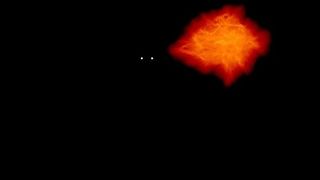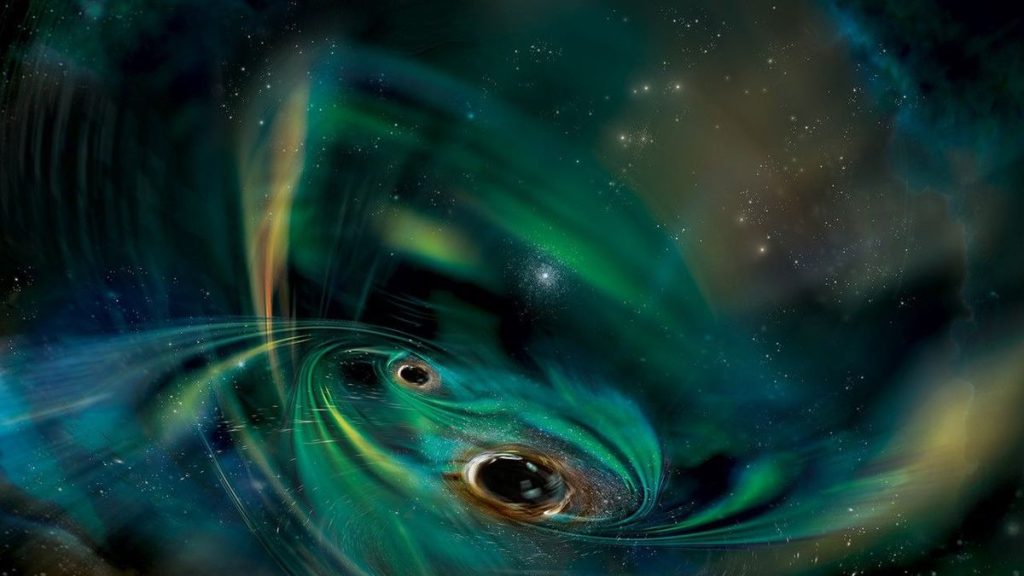Astronomers have stumbled upon a pair of massive black holes in a distant galaxy that are triggering unusual bursts of light. These bright emissions, which appear to peak on a regular cycle, may be caused by the black hole duo disrupting a massive gas cloud — a phenomenon researchers say is the first of its kind to be detected.
The cosmic behemoths reside at the center of a galaxy named 2MASX J21240027+3409114, located roughly 1 billion light-years away in the northern constellation Cygnus. These black holes complete an orbit once every 130 days while being just 16 billion miles (26 billion kilometers) apart — so close that light takes only a day to travel between them. Over the past three years, they have consumed roughly 1.5 to 2 solar masses of gas from the hovering gas cloud, and they are expected to collide and merge in about 70,000 years, the researchers report in a new study published Nov. 13 in the journal Astronomy & Astrophysics.
Astronomers were first alerted to the strange emissions in March 2021 by an automated alert system that uses data from the Zwicky Transient Facility (ZTF) in California to spot rapidly flaring objects in the northern sky. Initially, the event was flagged as a potential supernova due to the sudden brightening pattern. However, subsequent outbursts in 2022 prompted the study team to explore other explanations.
The event was soon reclassified as an active galactic nucleus (AGN), a term used for a black hole that feeds on material from a surrounding accretion disk. However, spectra obtained from observatories in Mexico, India and Spain traced an intriguing M-shaped pattern in the data that recurred every two to three months, a cadence that neither a supernova nor an AGN could explain.
Related: Astronomers spot unusually synchronized star formation’ in ancient galaxy for 1st time
“This is very different from anything I have seen before,” study lead author Lorena Hernández-García, who is an astrophysicist at the Millennium Institute of Astrophysics in Chile, told Space.com.
In 2022, Hernández-García and her team observed the same M-shaped spectral pattern in both X-ray and ultraviolet wavelengths in data from the Neil Gehrels Swift Observatory. “That’s when we said, ‘This is something interesting,'” she said. “I’m looking at the light curve more or less every day to see what’s happening.”

So far, the data hasn’t shown any characteristics of a tidal disruption event, or TDE, where a star is torn apart by a black hole’s gravity. The model that best fits the data suggests a massive gas cloud approached the galaxy on a trajectory perpendicular to the orbit of the two black holes. Larger than the binary system itself, the gas cloud would have then gotten torn apart by the black holes’ immense gravitational forces. If this is indeed the case, the M-shaped emissions can be explained by hunks of gas that are ejected into space each time a black hole swooshes through the gas cloud.
Nevertheless, the researchers are not yet ruling out the possibility of a previously unknown type of partial TDE occurring in this galaxy, Hernández-García said.
Additionally, the ongoing merger of this galaxy with another one to its south, about 29,000 light-years away, may be generating significant dust. Astronomers expect gas clouds like the newfound one to be common in many merging galaxies that host binary black holes, but none have been detected before. Hernández-García attributes the lack of previous detections to limited instrumentation, and noted that, since ZTF began operations in 2018, “we are finding a lot of weird stuff that wasn’t possible to see before.”
Due to the galaxy’s vast distance from Earth, telescopes cannot directly observe the gas cloud or the black hole duo. The study team is now brainstorming new observations to track the gas cloud and determine its origins — whether it is inherent to the galaxy, a byproduct of the ongoing merger, or just a passing interloper.

